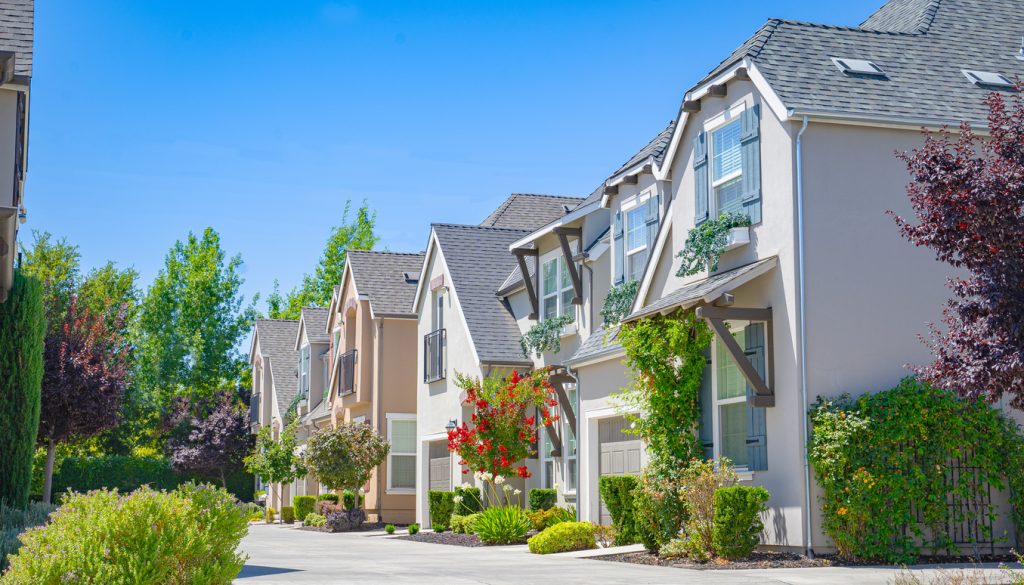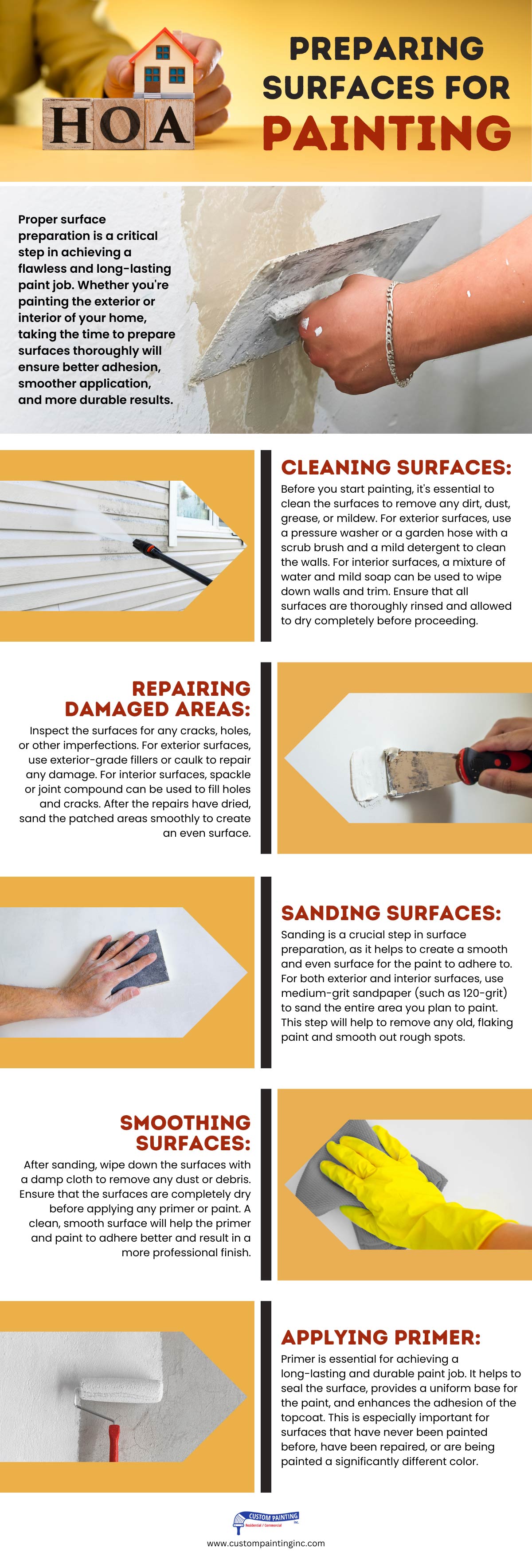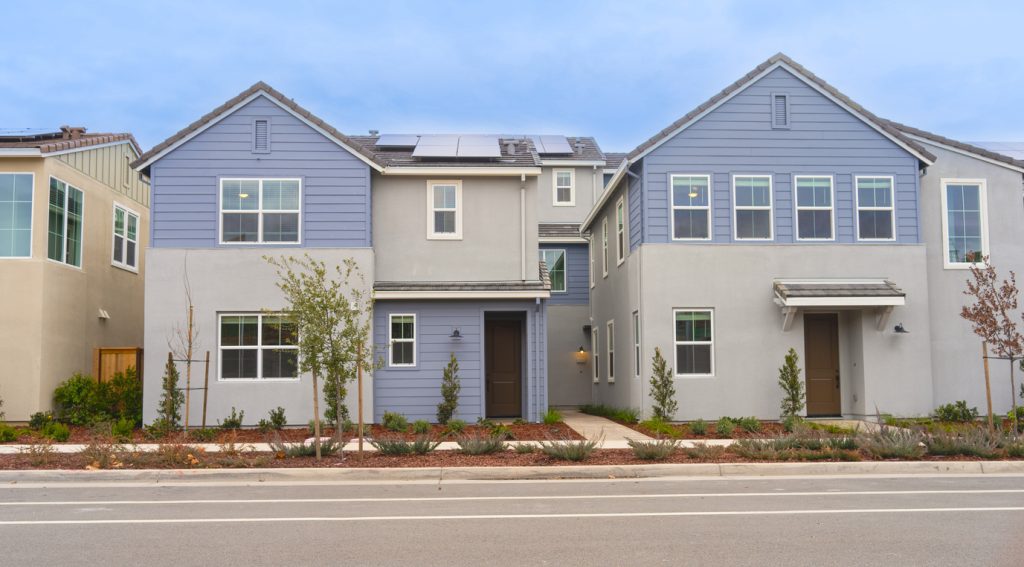Keeping your home looking great is important, especially in a community with a Homeowners Association (HOA). Regular painting and maintenance not only enhance your home’s appearance but also help you stay in good standing with your HOA. In this post, we’ll share some easy tips to help you maintain your home’s exterior and keep it looking its best.
Understanding HOA Guidelines and Standards
Maintaining your home’s exterior involves more than just personal preference, especially in a community governed by a Homeowners Association (HOA). Each HOA has specific guidelines and standards that homeowners must follow to ensure uniformity and aesthetic appeal throughout the neighborhood.
1. Reviewing HOA Rules and Regulations
Before starting any painting or maintenance project, it’s crucial to review your HOA’s rules and regulations. Each HOA has specific requirements regarding the appearance and upkeep of homes within the community. These rules are designed to maintain a uniform and attractive look throughout the neighborhood.
2. Importance of Understanding Specific Painting and Maintenance Requirements
Understanding these guidelines helps avoid any potential conflicts with the HOA and ensures that your efforts comply with community standards. Specific requirements may include approved color schemes, types of materials that can be used, and designated maintenance schedules.
3. Common Guidelines Related to Color Schemes, Materials, and Maintenance Schedules
Many HOAs provide a list of approved exterior paint colors to ensure that homes maintain a cohesive look. They may also specify the types of materials acceptable for repairs and improvements. Additionally, there might be schedules for when certain maintenance tasks should be performed, such as power washing or repainting every few years.
14. Compliance with Community Aesthetics
Keeping in line with your community’s aesthetic standards is key to maintaining a harmonious and pleasing environment. In this section, we’ll explore how to align your painting and maintenance efforts with the overall community aesthetics and provide examples of approved color palettes and styles.
5. Ensuring that Painting and Maintenance Efforts Align with the Overall Community Aesthetics
When planning your painting and maintenance projects, it’s essential to ensure they align with the overall aesthetics of the community. This not only helps maintain the neighborhood’s visual appeal but also keeps you in good standing with your HOA.
6. Examples of Approved Color Palettes and Styles
Most HOAs provide examples of approved color palettes and styles that homeowners can choose from. These might include neutral tones, earth colors, or specific shades that match the community’s theme. For instance, if your neighborhood has a Mediterranean style, the HOA might approve colors like terracotta, beige, and olive green. Using these approved palettes helps create a harmonious look across all homes in the area.
By understanding and following your HOA’s guidelines and standards, you can ensure that your home not only looks great but also complies with community rules. This helps maintain the overall beauty and value of your neighborhood.
Selecting the Right Paint and Materials
Choosing the right paint and materials for your home is crucial for achieving a long-lasting and appealing finish. Using high-quality, durable paints for your home’s exterior and interior surfaces can make a significant difference in the appearance and longevity of your paint job.
1. Benefits of Using High-Quality, Durable Paints
High-quality paints provide better coverage, longer-lasting color, and improved resistance to weather and wear. They are less likely to peel, crack, or fade, reducing the need for frequent repainting. Additionally, these paints often have better adhesion properties, which helps them stick to surfaces more effectively, resulting in a smoother, more professional finish.
2. Recommendations for Paint Types Suited to Different Environments and Surfaces
- Exterior Surfaces: Consider using acrylic latex paint for exterior surfaces. It is durable, resistant to the elements, and flexible enough to withstand temperature fluctuations. Look for paints specifically formulated for areas exposed to high moisture or direct sunlight.
- Interior Surfaces: Eggshell or satin finishes are popular choices for interior walls due to their easy maintenance and subtle sheen. For high-traffic areas or spaces prone to moisture, such as kitchens and bathrooms, semi-gloss or gloss finishes offer enhanced durability and washability.
3. Eco-Friendly and Low-VOC Options
Selecting environmentally friendly and low-VOC (volatile organic compounds) paints is essential for health and sustainability. These paints reduce harmful emissions and contribute to healthier indoor air quality.
4. Importance of Selecting Environmentally Friendly and Low-VOC Paints
Low-VOC and eco-friendly paints minimize the release of toxic fumes, which can cause respiratory issues and other health problems. They also reduce the environmental impact by lowering the amount of harmful chemicals released into the atmosphere during and after application.
5. Overview of Available Eco-Friendly Products
There are many eco-friendly and low-VOC paint options available on the market today. Some brands specialize in producing paints that are both high-quality and environmentally responsible. Look for labels such as “low-VOC,” “zero-VOC,” or “Green Seal” certified when selecting paints. These products often perform just as well as traditional paints while being safer for your family and the environment.
By choosing the right paints and materials, you can ensure that your home looks beautiful and stands up to the elements while also promoting a healthier living environment and supporting sustainability.
Preparing Surfaces for Painting
Proper surface preparation is a critical step in achieving a flawless and long-lasting paint job. Whether you’re painting the exterior or interior of your home, taking the time to prepare surfaces thoroughly will ensure better adhesion, smoother application, and more durable results.
1. Cleaning Surfaces
Before you start painting, it’s essential to clean the surfaces to remove any dirt, dust, grease, or mildew. For exterior surfaces, use a pressure washer or a garden hose with a scrub brush and a mild detergent to clean the walls. For interior surfaces, a mixture of water and mild soap can be used to wipe down walls and trim. Ensure that all surfaces are thoroughly rinsed and allowed to dry completely before proceeding.
2. Repairing Damaged Areas
Inspect the surfaces for any cracks, holes, or other imperfections. For exterior surfaces, use exterior-grade fillers or caulk to repair any damage. For interior surfaces, spackle or joint compound can be used to fill holes and cracks. After the repairs have dried, sand the patched areas smoothly to create an even surface.
3. Sanding Surfaces
Sanding is a crucial step in surface preparation, as it helps to create a smooth and even surface for the paint to adhere to. For both exterior and interior surfaces, use medium-grit sandpaper (such as 120-grit) to sand the entire area you plan to paint. This step will help to remove any old, flaking paint and smooth out rough spots.
4. Smoothing Surfaces
After sanding, wipe down the surfaces with a damp cloth to remove any dust or debris. Ensure that the surfaces are completely dry before applying any primer or paint. A clean, smooth surface will help the primer and paint to adhere better and result in a more professional finish.
5. Applying Primer
Primer is essential for achieving a long-lasting and durable paint job. It helps to seal the surface, provides a uniform base for the paint, and enhances the adhesion of the topcoat. This is especially important for surfaces that have never been painted before, have been repaired, or are being painted a significantly different color.
Select a primer that is appropriate for the surface you are painting. For exterior surfaces, use an exterior-grade primer that can withstand the elements. For interior surfaces, choose a primer suited for the type of paint you plan to use (e.g., oil-based or latex). Apply the primer evenly using a brush or roller, and allow it to dry completely before painting.
By following these steps for preparing surfaces, you can ensure a smooth and long-lasting paint job that will enhance the appearance and durability of your home. Proper preparation is the key to achieving professional results and enjoying a beautiful, well-maintained home.
Best Practices for Painting HOA Homes
Painting your home within an HOA community requires careful planning and attention to detail. By following best practices for both exterior and interior painting, you can achieve professional results that meet HOA standards and enhance your home’s appearance.
1. Exterior Painting Tips
- Plan According to Weather Conditions: When painting the exterior of your home, choose a time when the weather is dry and mild. Avoid painting in extreme temperatures, high humidity, or during rain to ensure the paint adheres properly and dries evenly.
- Use Quality Materials: Invest in high-quality exterior paints and primers that are designed to withstand the elements. These products will provide better coverage, durability, and resistance to fading and peeling.
- Follow HOA Guidelines: Adhere to your HOA’s guidelines regarding color schemes and materials. Choose colors from the approved palette and use materials specified by the HOA to maintain community aesthetics.
- Proper Surface Preparation: Thoroughly clean and repair the surfaces before painting. Remove any loose or peeling paint and sand rough areas to create a smooth surface. Apply a suitable primer to ensure the topcoat adheres well and lasts longer.
- Apply Paint Evenly: Use even, consistent strokes when applying paint to avoid drips and uneven coverage. Apply multiple thin coats rather than a single thick coat for a smoother and more durable finish.
2. Interior Painting Tips
- Protect Your Space: Before starting, cover furniture, floors, and fixtures with drop cloths or plastic sheeting. Use painter’s tape to protect trim, baseboards, and other areas you don’t want to be painted.
- Choose the Right Paint Finish: Select the appropriate paint finish for each room. For example, use satin or eggshell finishes for living areas and bedrooms and semi-gloss or gloss finishes for kitchens and bathrooms where durability and easy cleaning are essential.
- Test Paint Colors: Test paint colors on a small area of the wall to see how they look in different lighting conditions. This helps you choose the best color before committing to painting an entire room.
- Prepare Surfaces: Clean walls to remove dust, grease, and grime. Repair any holes or cracks with spackle and sand them smooth. Apply a primer if necessary to ensure even coverage and better adhesion of the topcoat.
- Use Quality Tools: Invest in high-quality brushes and rollers to achieve a smooth and even finish. Quality tools make the application process easier and result in a more professional-looking paint job.
- Work Methodically: Start by cutting in around the edges of the walls and along the trim with a brush. Then, use a roller to fill in the larger areas, working in small sections and using a “W” or “M” pattern for even coverage.
By following these best practices for exterior and interior painting, you can achieve beautiful, lasting results that enhance your home’s appearance and comply with HOA standards. Taking the time to plan and execute your painting projects properly ensures a professional finish that you can be proud of.
Regular Maintenance and Upkeep
Maintaining your home’s exterior and interior is crucial for preserving its appearance and value, especially in an HOA community where standards must be met. Regular maintenance not only enhances your home’s curb appeal but also prevents costly repairs in the long run.
1. Exterior Maintenance
- Routine Inspections: Conduct regular inspections of your home’s exterior to identify any issues early. Look for signs of damage, such as cracks, peeling paint, or moisture buildup. Addressing problems promptly can prevent more significant issues down the line.
- Cleaning: Regularly clean the exterior surfaces to remove dirt, mold, and mildew. Use a pressure washer for a thorough cleaning of walls, siding, and driveways. For delicate areas, a gentle scrub with a brush and mild detergent will suffice. Keeping your home’s exterior clean helps maintain its appearance and prevents damage.
- Gutter Maintenance: Clean your gutters at least twice a year to prevent clogs and water damage. Ensure that downspouts are clear and directing water away from your home’s foundation. Proper gutter maintenance protects your roof and walls from water-related issues.
- Landscaping Care: Maintain your landscaping by trimming bushes, mowing the lawn, and removing weeds. Well-kept landscaping enhances your home’s curb appeal and complies with HOA standards. Additionally, keeping plants away from your home’s walls can prevent moisture and pest problems.
- Paint Touch-Ups: Inspect painted surfaces regularly for chips and peeling. Touch up these areas to maintain a fresh appearance and protect the underlying materials from the elements. Use the same high-quality paint and colors approved by your HOA.
2. Interior Maintenance
- Paint Touch-Ups: Inspect painted surfaces regularly for chips and peeling. Touch up these areas to maintain a fresh appearance and protect the underlying materials from the elements. Use the same high-quality paint and colors approved by your HOA.
- HVAC Maintenance: Service your heating, ventilation, and air conditioning (HVAC) system regularly. Replace filters as needed and schedule professional inspections and cleanings to ensure your system operates efficiently and maintains good indoor air quality.
- Plumbing Checks: Inspect plumbing fixtures and pipes for leaks or damage. Address any issues promptly to prevent water damage and mold growth. Regularly clean drains and use strainers to prevent clogs.
- Paint and Wall Maintenance: Keep interior walls in good condition by addressing scuffs, scratches, and dents. Touch up paint as needed and ensure that high-traffic areas receive extra attention. Regularly inspect and clean walls to maintain their appearance.
- Appliance Maintenance: Perform routine maintenance on household appliances to extend their lifespan and ensure they function efficiently. Clean refrigerator coils, check oven seals and inspect washing machine hoses for signs of wear.
By incorporating these regular maintenance and upkeep practices into your routine, you can keep your home looking its best and avoid costly repairs. Staying proactive in maintaining your home ensures that it remains a beautiful and valuable asset within your HOA community.
Working with Professional Painters
Hiring professional painters can be a smart decision when it comes to maintaining and enhancing your home’s appearance. Professional painters bring expertise, efficiency, and high-quality results that can save you time and effort.
1. Benefits of Hiring Professionals
- Expertise and Experience: Professional painters have the skills and experience to handle various painting projects efficiently. They are knowledgeable about the best techniques, materials, and products to use, ensuring a high-quality finish. Their expertise helps in addressing any challenges that may arise during the project, such as dealing with difficult surfaces or weather conditions.
- Time-Saving: Painting a home, especially the exterior, can be time-consuming and labor-intensive. Thanks to their experience and access to the right tools and equipment, professional painters can complete the job much faster than a homeowner working alone. This allows you to enjoy a freshly painted home sooner without the stress and hassle of a DIY project.
- High-Quality Results: A professional painting company guarantees a superior finish that can enhance your home’s curb appeal and value. They ensure even application, smooth surfaces, and proper coverage, which contribute to the longevity and durability of the paint job. Their attention to detail and commitment to quality result in a polished, professional look.
- Safety: Painting can involve working at heights, handling chemicals, and using specialized equipment. Professional painters are trained in safety procedures and have the necessary gear to complete the job safely. Hiring professionals reduces the risk of accidents and injuries, ensuring the safety of both your family and the workers.
- Warranty and Insurance: Reputable painting companies offer warranties on their work, providing peace of mind that any issues will be addressed promptly. Additionally, they carry insurance to protect against accidents or damage that may occur during the project. This coverage ensures that you are not liable for any unexpected costs.
2. Selecting the Right Painting Company
- Research and Recommendations: Start by researching local painting companies and asking for recommendations from friends, family, or neighbors who have had positive experiences. Online reviews and testimonials can also provide insight into a company’s reputation and quality of work.
- Verify Credentials: Ensure that the painting company is licensed, bonded, and insured. A valid license indicates that the company meets industry standards and regulations, while insurance protects you from liability in case of accidents or damage. Verify these credentials before hiring a company.
- Request Estimates: Obtain detailed estimates from multiple painting companies to compare pricing and services. A comprehensive estimate should include the cost of materials, labor, and any additional services such as surface preparation or cleanup. Be wary of estimates that are significantly lower than others, as they may indicate subpar quality or hidden costs.
- Check References: Ask the painting company for references from previous clients. Contact these references to inquire about their experience with the company, the quality of the work, and their satisfaction with the results. Positive feedback from past clients is a good indicator of a reliable and professional company.
- Review Contracts: Carefully review the contract before signing, ensuring that all details of the project are clearly outlined. This should include the scope of work, timeline, payment schedule, and any warranties or guarantees. A well-defined contract helps prevent misunderstandings and ensures that both parties are on the same page.
By hiring professional painters and selecting the right company, you can ensure a high-quality, hassle-free painting project that enhances your home’s appearance and value. The expertise and efficiency of professionals provide peace of mind and exceptional results that you can enjoy for years to come.
Conclusion
Maintaining and painting your home within an HOA community doesn’t have to be stressful. By following these tips for understanding guidelines, selecting the right materials, preparing surfaces, and working with professional painters, you can ensure your home looks its best and complies with community standards.
For professional painting services, contact Custom Painting, Inc. at 925-866-9610 or fill out our contact form to schedule an appointment. Enjoy a beautiful, well-maintained home with the help of our expert team.






